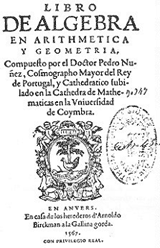|
Pedro Nunes (1502-1578)
 |
|
|
|
He was born in Alcácer do Sal in 1502, of Jewish descent. He pursued the courses of Philosophy and Mathematics at the University of Lisbon, where he obtained a bachelor’s degree in Medicine in 1525. In 1529, he became responsible for the subject of Moral Philosophy, moving on to Logic and then Metaphysics. By charter of 1529, king D. João III nominated him cosmographer, with a pension of twenty thousand reis per year, a position which was confirmed in 1541, with the pension increasing twofold. In 1547, he became principal cosmographer, earning fifty thousand reis per year. In 1531, he went to Évora as the princes’ tutor.
Shortly after the transfer of the University to Coimbra, Pedro Nunes was nominated professor of this University in 1544, a position he held until his jubilee in 1562. As cosmographer, he was often away from Coimbra to attend to requests by the king to resolve technical nautical problems.
Between 1562 and 1572, he moved away from the court and lived in Coimbra; however, D. Sebastião called him back to service as a cosmographer in 1572. It is believed to have been from this moment on that he concerned himself with a “lesson on the sphere” (astronomy and cosmography) directed at pilots, navigators and cartographers. In 1568, he was entrusted by D. Sebastião with the reform of the weights and measures of the kingdom, which was promulgated in 1575.
He died in Coimbra in 1578.
Works
|
 |
|
|
In 1537, he published a book with the following texts: 1st Tratado da Esfera; 2nd Teoria do movimento do Sol e da Lua; 3rd Tratado de Geografia de Ptolomeu; 4th Tratado de algumas duvidas da navegação; 5th Tratado em defensam da carta de marear. The first three treaties are commented translations of works by Sacrobosco, Purbaquio and Ptolomy.
He published a pamphlet which is a summary of the Treaty of the Sphere, by João Sacrobosco, in Latin, with the title Astronomici Introductori de Sphaere Epitome, which had no date but which is thought to have been published between 1537 and 1542. In 1542, he published De Crepusculis Libri Unus, where he studies the duration of twilight in relation to the latitude and to the period of the year.
In 1546, he published De Erratis Orontii Finaei, a critical analysis of a work in which the French mathematician mistakenly claimed to have resolved three classical geometry problems which were later proved to be impossible (the quadrature of the circle, the duplication of the cube and the trisection of any angle). Twenty years later, in 1566, he published Petri Nonii Salaciensis Opera, where he included several works related to the art of navigating, in Latin. In 1567, came Libro de Álgebra en Arithmetica y Geometria, in Castilian. He also published De arte atque Navigandi, of which the edition of 1573 is known, although there is information on a previous publication in 1546. He left some manuscripts, among which the following are known: Defensam do Tratado de Rumaçao do Globo para a Arte de Navegar; Algebra.
Main scientific contributions
From among the scientific contributions of Pedro Nunes, his studies on loxodromy deserve special mention. This concept was discovered by Pedro Nunes and is the basis of the projection system of the Mercator maps. Pedro Nunes showed that in general a rhumb line, later called loxodrome, i.e. a path that always follows the same cardinal direction, would make a spiral that would circle the poles of the earth an infinite number of times (the only circular rhumb lines are the meridians and the parallels, which correspond to the rhumb angles of zero and ninety degrees in relation to the north-south axis). In the same way he discovered that the shortest distance between two points on the surface of the earth is an orthodrome, i.e. a great circle arc that passes through both points. He therefore reached the conclusion that maps should have two properties: they should preserve angles and they should represent rhumb lines as straight lines.
It can be said of Pedro Nunes that although he was unable to consummate his theories in drawing up maps, he opened the way for the drawing up of new maps to be used by navigators, later achieved by Gerardus Mercator (1512-1594), who revolutionised cartography.
Another important contribution was the invention of the nonius. This theoretical instrument made it possible to read fractions of a degree in two nautical instruments used at the time, the astrolabe and the quadrant. The concept underlying this instrument was later perfected by Christopher Clavius (1537-1612) and by Pierre Vernier (1584-1638), which meant it became easier to build and more common in the eighteenth century.
Fernando Reis
Links
História das Matemáticas em Portugal
Scientia - Pedro Nunes
Centro Virtual Camões - Filosofia Portuguesa - Pedro Nunes
Bibliography
ALBUQUERQUE, Luís, "Nunes, Pedro", in SERRÃO, Joel, Dicionário de História de Portugal, Porto, Figueirinhas, 1981, vol. IV, pp. 407-408.
COSTA, A. Fontoura da, Pedro Nunes (1502-1578), Lisboa, Agência Geral do Ultramar, 1969.
GUIMARÃES, Rodolfo, "Vida e descendência de Pedro Nunes", Boletim da Segunda Classe da Academia das Sciências de Lisboa, 9,
1914-15, pp. 122-141.
REIS; A. Estácio dos, "O Nónio de Pedro Nunes", Oceanos, 38, Abril/Junho 1999, pp. 67-79.
SILVA, Inocencio da, ARANHA, Brito, Diccionario Bibliographico Portuguez, Lisboa, Imprensa Nacional, T. VI, pp. 437-442.
TEIXEIRA, Francisco Gomes, História das Matemáticas em Portugal, Lisboa, Academia das Ciências de Lisboa, 1934.
|
|


